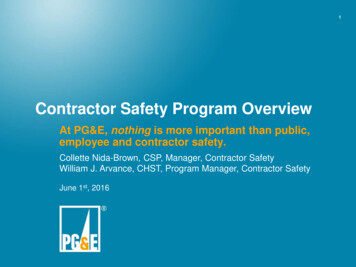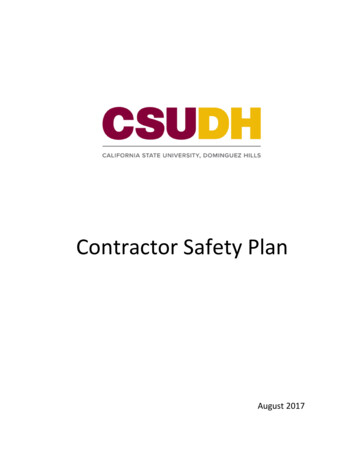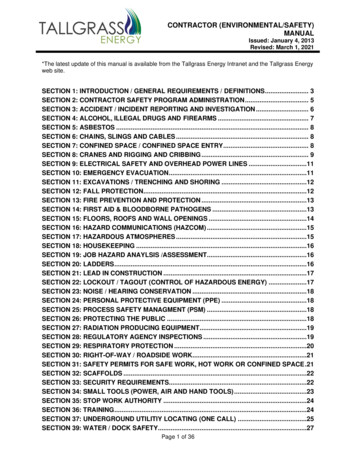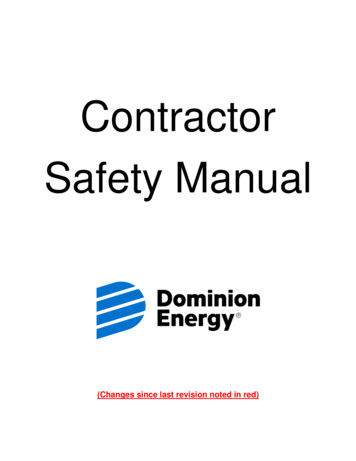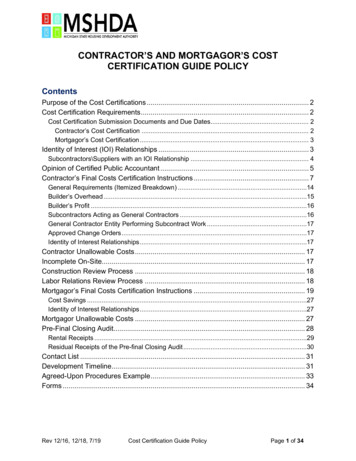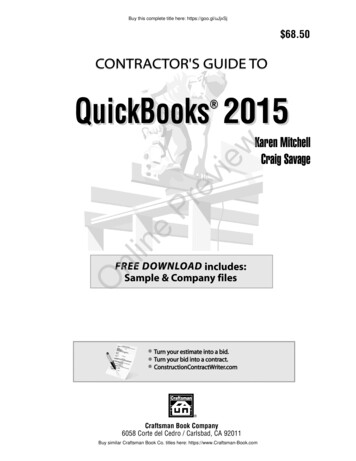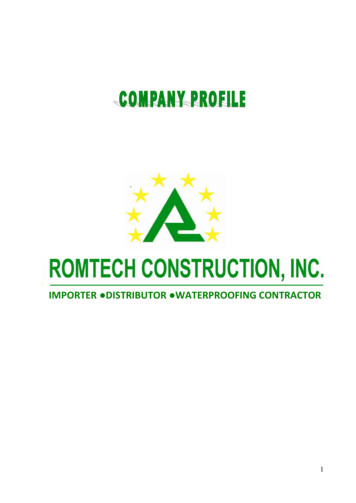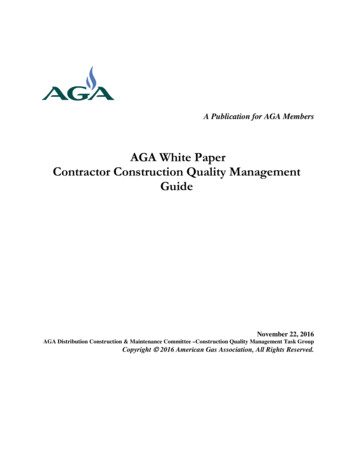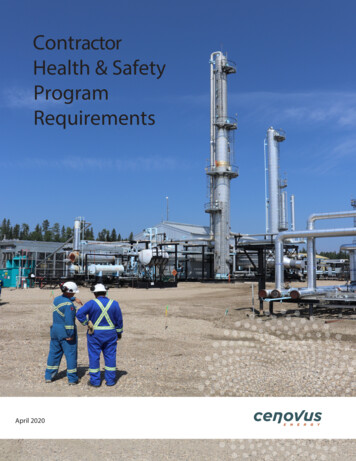
Transcription
ContractorHealth & SafetyProgramRequirementsApril 2020
Contractor Health and Safety Program RequirementsCEN-EHS8856 Version 5.0Issued: July 30, 2015 Revised: April 20, 2020Table of ContentsCore Program requirements are indicated using the Pin Icon. For moreinformation on Cenovus’s Core Programs, see section 3.0 Cenovus health & safetyrequirements.1.02.03.04.0Purpose .4Scope .4Cenovus health & safety requirements overview .43.1Requirement hierarchy . 53.2Health & safety program requirements in Contractor Management . 6Subcontracting .95.0ISNetworld subscription .115.1New Contractors . 115.2Cenovus Contractors . 115.3Cenovus Contractors Dashboard Requirements . 116.0Contractor’s H&S program & performance verification .127.0Cenovus policies & acknowledgments .138.0Regulatory disclaimer & industry standards .139.0Risk management & hazard assessment program .139.1Assessment activities . 1410.011.0Contractors health and safety management commitment .15Occupational health management requirements.1612.011.1Alcohol and drug policy . 1611.211.311.411.511.611.711.8Provision of emergency medical services . 17Infectious diseases . 17Medical fitness for work . 18Manual material handling program . 19Disability management program . 19Fatigue management . 20Occupational hygiene program . 2011.9Hazardous materials management program . 2011.10 Asbestos Program . 2111.11 Hydrogen sulphide program . 2211.12 Benzene program . 2211.13 Respiratory protection program . 2311.14 Hearing conservation program . 2311.15 Thermal exposure & stress prevention program . 2411.16 Naturally occurring radioactive materials (NORM) . 24Safety management requirements .2412.112.212.3Adherence to Cenovus’s Safety Commitments and Life Saving Rules . 25Firearms and weapons . 27Smoking . 2712.4Competency and health & safety training program . 27Uncontrolled when printed Cenovus All rights reservedPage 2 of 52
Contractor Health and Safety Program RequirementsCEN-EHS8856 Version 5.0Issued: July 30, 2015 Revised: April 20, 202012.512.612.712.8New, young, and short service workers program . 28High-hazard worksite health & safety staffing . 29Safe work procedures . 29Safe work permitting system . 2912.9Workplace and equipment inspection program . 3012.10 Health and safety communications program . 3012.11 Health & safety reporting . 3112.12Health & safety management of change (MOC) program . 3212.13 Behaviour observation program . 3212.14 Hazard ID & near miss reporting program . 3213.012.15Incident management program . 35Emergency management and response . 36Personal protective equipment (PPE) . 36Machine, equipment, hand tool, and knife, hazard control program(s) . 37Scaffold inspection program . 38Portable ladder safety program. 38Safety barrier erection and maintenance program . 38Worksite housekeeping program . 39Preventative maintenance program . 39Rigging, lifting, and hoisting equipment program . 40Cranes, hoists, and lifting devices . 40Fall protection program . 41Fire and explosion prevention program . 42Welding, cutting, and grinding safety program . 43Ground disturbance program . 43Adherence to Cenovus Electrical Work Practice (EWP) . 44Working around overhead utilities program . 45Energy isolation program . 45Confined space entry program . 46Working alone program . 47Winter work program . 4712.36Workplace violence and harassment program . 4712.37 Driving/ vehicle safety program . 4812.38 Commercial Vehicle Safety Program . 49References .5013.1 Definitions and acronyms . 50List of Tables/ FiguresFigure 1: Program requirement hierarchy . 5Table 1: Program hierarchy descriptors . 5Figure 2: Identifying H&S requirements . 6Figure 3: Life Saving Rules . 26Table 2: Contractor Incident Management Expectations . 34Figure 4 - Cenovus Incident Risk Ranking . 35Table 3: Terms and Definitions . 50Table 4: Acronyms, Initialisms and Abbreviations . 51Uncontrolled when printed Cenovus All rights reservedPage 3 of 52
Contractor Health and Safety Program RequirementsCEN-EHS8856 Version 5.0Issued: July 30, 2015 Revised: April 20, 20201.0PurposeAs Prime Contractor, Cenovus requires all our contractors, and their subcontractors, tosupport our health and safety goals and commitments. The purpose of the ContractorHealth and Safety Program Requirements is to provide guidance and ensure completetransparency on Cenovus’s minimum health and safety (H&S) requirements for work atCenovus field sites. Through the alignment of health and safety programs, a commonapproach to the management of worksite hazards can be taken by all worksite parties.This will help ensure that contractors bidding on Cenovus onsite work are aware ofCenovus’s H&S program requirements before signing a Cenovus agreement or contract.These requirements are referenced within Cenovus service agreements and contracts andare therefore binding.2.0ScopeThe requirements outlined within this document are intended to address the basic hazardsfound on Cenovus field sites. Therefore, the scope of this document applies to allcontractors who conduct work on Cenovus-owned and/or operated field sites, includingcontractors who use subcontractors to complete the work scope on a Cenovus-ownedand/or operated field site.Additional requirements not outlined within this document may be identified to address workscope specific hazards and/or business function requirements.Work scopes that do not require a contractor to send employees or subcontracted workersto Cenovus field sites are not included within the scope of this document.3.0Cenovus health & safety requirements overviewCenovus has identified minimum health and safety requirements that a contractor mustmeet and/or follow to conduct work on any Cenovus field site. The health and safetyrequirements outlined within this document allow Cenovus: As Prime Contractor, to coordinate the health and safety programs of all employers onour worksites; and As Worksite Owner, to supply the necessary health and safety information to all worksiteparties by communicating known worksite hazards and controls, notably Cenovus’s workpractices, programs, and procedures.11Disclaimer: Any information published on or obtained through a link from Cenovus’s website or ISNetworld may not include allapplicable H&S requirements. Additional requirements may be required for specific jobs, functions or for particular contractors.Also, additional requirements or more updated practices may have been developed and disseminated such that contractors ought toreasonably be aware of such requirements or updated practices, since the date of publication to the Cenovus website, in which casecontractors are obligated to ensure the implementation of such recent requirements and updated practices. For specific questionsrelated to Cenovus’s H&S requirements, contact contractorsafety@cenovus.com.Uncontrolled when printed Cenovus All rights reservedPage 4 of 52
Contractor Health and Safety Program RequirementsCEN-EHS8856 Version 5.0Issued: July 30, 2015 Revised: April 20, 20203.1Requirement hierarchyThe health and safety requirementsoutlined within this document areprescribed as a control to addressidentified hazards that are known to beexisting on a Cenovus worksite, or thathave the potential to exist. However, theapplicability of the programs will varybetween work scopes and exposure tothe specific hazard(s). As a result, thehealth and safety requirements outlinedwithin the Contractor Health & SafetyProgram Requirements can be viewedthrough three distinct lenses.Figure 1: Programrequirement hierarchyCoreProgramsWork ScopeRequiredProgramsHazardAwarenessTable 1: Program hierarchy descriptorsProgramhierarchyCoreProgramsHierarchy descriptorCenovus’s health and safety requirements that apply to all scopes of work areknown as Core Programs. A requirement is determined to be a Core Programbased upon: Program elements required by legislation (not work scope specific) Health and safety requirements that support Cenovus’s core values orinternal contractor management processesCenovus’s Core Program are indicated by the following us’s health and safety requirements that are determined to be requiredfor the scope of work being conducted are known as Work Scope RequiredPrograms. Work Scope Required Programs are determined to be required byconsidering the following: Work scope hazards In ISNetworld, RAVS Programs assigned to the “work type(s)” thecontractor will be performing Cenovus Business Unit/Function specific required H&S program and/orcontrolsWhere the contractor does not perform the type of work for which a programis intended, a formal health and safety program is not required. However, thecontractor must ensure that there is a method to inform their workers of thehazard and communicate the necessary controls.The contractor may provide hazard awareness using informal communicationmethods such as: Documented toolbox talks Orientations Safety bulletins, or Formally, using documented programsUncontrolled when printed Cenovus All rights reservedPage 5 of 52
Contractor Health and Safety Program RequirementsCEN-EHS8856 Version 5.0Issued: July 30, 2015 Revised: April 20, 2020Additional requirements not outlined within this document may be identified toaddress work scope specific hazards and/or business function requirements3.1.1Identifying health & safety requirementsWhen a need for materials or services is identified, Cenovus End users mustdevelop a comprehensive scope of work, complete with known risks and requiredmitigations. This allows Cenovus to identify the specific health & safetyrequirements, expectations, and qualifications that a contractor must meet to bequalified to be considered to deliver the scope.Figure 2: Identifying H&S requirementsWhat requirementsare applicable to thework scope? Work-related hazards &controls Risk-based requirements Function-specific requirementsWhat requirementsare applicable to allwork scopes? Legislative requirements Cenovus core values &expectationsHealth andsafetyrequirements Core Programs Work Scope RequiredContractors are to develop and implement such policies, programs, procedures,practices, guidelines, training, and other documentation to effectively meet orexceed Cenovus’s H&S requirements. These criteria are assessed in qualificationand verified through the use of assurance activities throughout the life of thecontract.3.2Health & safety program requirements in Contractor ManagementCenovus utilizes the Contractor Health and Safety Program Requirements tosupport both qualification and verification activities in Supplier Management.3.2.1Contractor H&S qualificationBefore being hired to perform work for Cenovus, or if a Cenovus contractorrequires qualification for a different scope of work, the contractor's H&S programsmust be evaluated against Cenovus requirements as part of our H&S QualificationProcess.3.2.1.1Prequalification - ISNetworld in contractor H&S qualificationTo support Cenovus’s Contractor Qualification and Selection processes,Cenovus uses ISNetworld (ISN) to aid in the initial qualificationassessment of a contractor's H&S Management Systems and H&Sperformance. To assess if a contractor is capable of meeting Cenovus’sminimum H&S requirements, ISN conducts an initial assessment ofcontractor submitted information against established evaluationcriteria. Contractors must achieve and maintain an Approved Status orare otherwise not qualified to work on Cenovus field sites.Uncontrolled when printed Cenovus All rights reservedPage 6 of 52
Contractor Health and Safety Program RequirementsCEN-EHS8856 Version 5.0Issued: July 30, 2015 Revised: April 20, 2020Cenovus H&S Qualification Questionnaire (HSQQ)Cenovus’s H&S Qualification Questionnaire (HSQQ) functions as ahigh-level screening tool to allow Cenovus to understand if acontractor is equipped with the necessary H&S systems to meetCenovus requirements to undertake the work safely.Contractors must complete the Cenovus H&S QualificationQuestionnaire (HSQQ) as part of the Cenovus ISNetworld dashboard.In addition to program review and scoring by ISN as part of the RAVSprogram evaluation, the effectiveness of the implementation of theseH&S programs will be continuously verified throughout the SupplierLifecycle using H&S assurance activities.Completing the HSQQA contractor will follow the below steps to complete the Health &Safety Qualification Questionnaire (HSQQ):1.2.3.4.3.2.1.2Locate the Cenovus-specific requirements that apply to the workscope(s).Reference the applicable requirements within the ContractorHealth & Safety Program Requirements to review therequirements criteria.Examine the contractors’ health and safety program andprocesses to analyze against the established requirementcriteriaSelect the appropriate response to each question within thequestionnaire:a. Yes - The contractor has a program that meets the intent ofthe requirement.b. No - The contractor does not have a program that meets theintent of the requirement.c. N/A - The contractor does not conduct work for which therequirement is controlling but hazard awareness is provided.Contractor H&S assurance in contractor qualificationCenovus utilizes specific assurance activities to support H&SQualification. The scope and selection of assurance activity isdependant on the risk of the proposed work scope and CenovusBusiness Function’s requirements. Cenovus’s assurance activities areintended to help achieve complete alignment between the CenovusH&S Program Requirements and the H&S programs implemented by acontractor at Cenovus field locations.Health & Safety Program Gap AnalysisCenovus’s Health & Safety Program Gap Analysis is a multi-purposetool that supports contractor management throughout the supplierlifecycle. In contractor qualification, the Contractor H&S Gap Analysiscan be used for low-risk work scopes to identify alignment gapsbetween the contractor's and Cenovus's H&S programs. ForUncontrolled when printed Cenovus All rights reservedPage 7 of 52
Contractor Health and Safety Program RequirementsCEN-EHS8856 Version 5.0Issued: July 30, 2015 Revised: April 20, 2020information on its additional uses and applications, see section 3.2.2Contractor H&S performance verification.Completing the Health & Safety Program Gap AnalysisThe template outlines specific program requirements andexpectations that Cenovus has identified as necessary to addressthe basic hazards of our worksites.The contractor is expected to use this tool to identify if thecontractor has a program that meets the requirements outlined inthis document or proposes other controls that can be applied tomeet Cenovus’s expectations. This allows contractors todemonstrate to Cenovus that their safety programs, processes, orplans adequately address the known site hazards and hazardsrelated to their scope of work, while meeting the minimum Cenovusrequirements outlined on the following pages.Contractor health & safety program assessmentA Contractor Health & Safety Program Assessment is an assessmentlevel audit tool used to support qualification activities of high-hazardwork scopes. This audit tool is intended to evaluate if the contractor'ssafety programs are adequate for the scope of work being qualifiedfor.3.2.2Contractor H&S performance verificationCenovus utilizes sev
Cenovus’s health and safety requirements that are determined to be required for the scope of work being conducted are known as Work Scope Required Programs. Work Scope Required Programs are determined to be required by considering the following: Work scope hazards In ISNetworld
